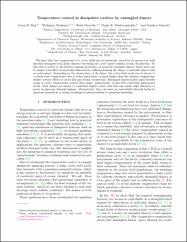Temperature control in dissipative cavities by entangled dimers
Künye
Dağ, C. B., Niedenzu, W., Özaydın, F., Müstecaplıoğlu, Ö. E. & Kurizki, G. (2019). Temperature control in dissipative cavities by entangled dimers. Journal of Physical Chemistry C, 123(7), 4035-4043. doi:10.1021/acs.jpcc.8b11445Özet
We show that the temperature of a cavity field can be drastically varied by its interaction with suitably entangled atom pairs (dimers) traversing the cavity under realistic atomic decoherence. To this end we resort to the hitherto untapped resource of naturally entangled dimers whose state can be simply controlled via molecular dissociation, collisions forming the dimer, or unstable dimers such as positronium. Depending on the chosen state of the dimer, the cavity-field mode can be driven to a steady-state temperature that is either much lower or much higher than the ambient temperature, despite adverse effects of cavity loss and atomic decoherence. Entangled dimers enable much broader range of cavity temperature control than single "phaseonium" atoms with coherently superposed levels. Such dimers are shown to constitute highly caloric fuel that can ensure high efficiency or power in photonic thermal engines. Alternatively, they can serve as controllable thermal baths for quantum simulation of energy exchange in photosynthesis or quantum annealing.
Kaynak
Journal of Physical Chemistry CCilt
123Sayı
7İlgili Öğeler
Başlık, yazar, küratör ve konuya göre gösterilen ilgili öğeler.
-
İki qubit’lik kuantum haberleşme ağlarının eş zamanlılık donanıklık ölçütü ile kuantum Fisher bilgisinin analizi
Erol, Volkan; Buğu, Sinan; Özaydın, Fatih; Altıntaş, Azmi Ali (IEEE, 2014-06-12)Kuantum dolanıklık, kuantum haberleşme mühendisliğinin en temel kavramlarından biridir. Kuantum sistemlerin dolanıklık ölçütlerine göre sıralanması günümüzde oldukça çok çalışılan konulardan birisidir. İki parçacıklı iki ... -
Kübit-Kütrit kuantum haberleşme sistemleri için negatiflik ve dolanıklığın göreceli entropisi ölçütlerinin analizi
Erol, Volkan; Altıntaş, Azmi Ali; Özaydın, Fatih (IEEE, 2015-06-19)Kuantum Bilgi Teorisi ve Kuantum Hesaplama konuları geleceğin bilgisayar teknolojisi olarak nitelendirilen ve çok yüksek hızlarda işlem yapacak olması öngörülen Kuantum Bilgisayarlarının teorik temelini oluşturan oldukça ... -
Engineering four-qubit fuel states for protecting quantum thermalization machine from decoherence
Özaydın, Fatih; Sarkar, Ramita; Bayrakçı, Veysel; Bayındır, Cihan; Altıntaş, Azmi Ali; Müstecaplıoğlu, Özgür E. (Multidisciplinary Digital Publishing Institute (MDPI), 2024-01-10)Decoherence is a major issue in quantum information processing, degrading the performance of tasks or even precluding them. Quantum error-correcting codes, creating decoherence-free subspaces, and the quantum Zeno effect ...


















